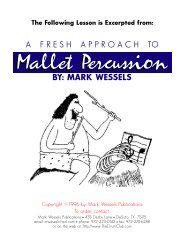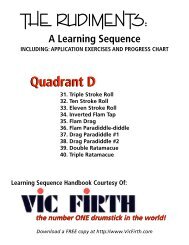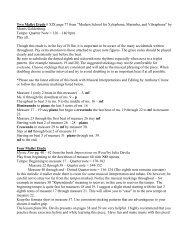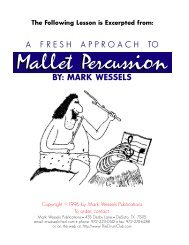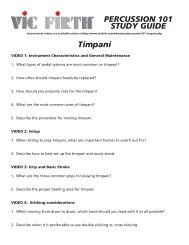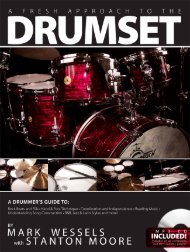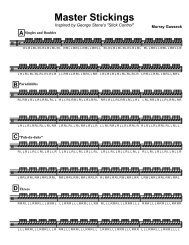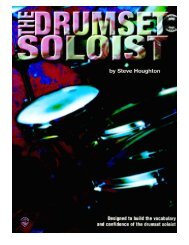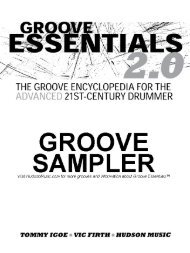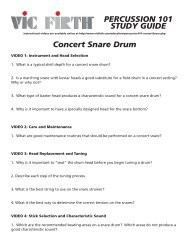Create successful ePaper yourself
Turn your PDF publications into a flip-book with our unique Google optimized e-Paper software.
39CHAPTER 13SCRAPESScrapes are one of the best reasons to play quads. Also commonlyreferred to as “sweeps,” scrapes are defined as diddles that areplayed on two different drums, the first beat of the diddle on any onedrum, and the second beat on a different drum. Scrapes are commonlyused for three reasons: musicality, logistics, and glamour. Musically,scrapes can offer new effects through new drum-to-drum combinations;logistically, they can help to move hands “out of the way,” tomake certain drum-to-drum combinations flow better. As far as glamouris concerned, scrapes just plain look cool!The hand motions used when scraping diddles are no differentthan they are when playing diddles on one drum. All diddles shouldbe played as two consecutive controlled legato strokes on a hand,using a combination of wrist, fingers, and at fast tempos, forearms.There are really only two types of scrapes: those scraping outward,away from the center of the body, and those scraping inward,towards the center of the body. There are no special considerationsneeded for playing outward scrapes. When playing INWARD scrapes,however, it’s helpful to turn your hands up a little so that the malletdownstrokes toward the first drum at an angle. The faster the tempo/lower the mallet height, the shallower the angle of the initialdownstroke. Although the hands themselves are turned up a little, thehand motion doesn’t change. DO NOT play inward scrapes with a“French grip;” the fulcrum must still be located where the player cancontrol the mallet’s side-to-side motion and his/her fingers can controlboth beats of each diddle. This is shown on the following page:
40NOTE: -The slight turning up of the hands should happen naturallyas one tries to play inward scrapes with the hands flat.When playing scrapes, it is imperative not to just “go with theflow” of the forearm’s motions; one must know exactly where eachbeat of each scrape is contacting the drums. For ease of movementand conservation of motion, be sure to play in the “scrape playingareas” (as shown in chapter 5 on set positions/playing areas). It is alsosometimes helpful to think about the three gaps between the drumsrather than the four drums themselves. Proper scrape technique canbe summed up as <strong>this</strong>: the hands turn from the wrist and incorporatethe use of fingers in order to play excellent quality diddles, while theforearms move the hands where they need to go around the drums.This is the key to playing scrapes with great sound quality.Now that the technique has been broken down, it’s time to getbehind the drums and play some quality scrapes. Remember to periodicallyreview the “12 GOLDEN QUAD RULES” on page 22.1. Right hand out÷ 4 œ œœ œ œœœœœœœœœœœœœ œ œœœ œ œœœ œ œœœ œ œœ œœœœœœœœœœœœœœœœ œ œ œœœ œ œœœ œ œœœ œ œœ(R R L L) →
2. Left hand out41÷ 4 œ œœ œ œœœœœœœœœœœœ(R R L L) →œœœ œœœœ œœœœ œœœœ œœœœœœœœœœœœœœœœœ œœœ œœœœ œœœœ œœœœ œ3. Right hand in÷ 4 œ œœ œ œœœœœœœœœœœœ(R R L L) →œ œ œœ œœœœ œœœœ œœœœ œœœœœœœœœœœœœœœœ œœœœ œœœœ œœœœ œœœœ4. Left hand in÷ 4 œ œœ œ œœœœœœœœœœœœ(R R L L) →œœ œœœœ œœœœ œœœœ œœ œœœœœœœœœœœœœœœœ œœ œœœœ œœœœ œœœœ œœ5. Right hand in and out÷ 4 œ œœ œ œœœœœœœœœœœœ(R R L L) →œ œ œœ œœœœœ œ œœ œœœœ œœœœœœœœœœœœœœœœ œ œ œœ œœœœœ œ œœ œœœœ6. Left hand in and out÷ 4 œ œœ œ œœœœœœœœœœœœ(R R L L) →œœœ œœœ œœœœœ œœœ œœ œœœœœœœœœœœœœœœœ œœœ œœœ œœœœœ œœœ œœ7. Both hands out÷ 4 œ œœ œ œœœœœœœœœœœœ(R R L L) →œœœœœœœœœœœœœœœœ œœœœœœœœœœœœœœœœ œœœœœœœœœœœœœœœœ8. Both hands in÷ 4 œ œœ œ œœœœœœœœœœœœœœœœœœœœœœœœœœœœ œœœœœœœœœœœœœœœœ œœœœœœœœœœœœœœœœ(R R L L) →
42NOTE: The forthcoming notes notated with x’s are cross-overs. Tobetter understand these, refer to Chapter 7 on cross-overs.9. Figure eights out÷ 4 œ œœ œ œœœœœœœœœœœœ(R R L L) →œ œœ œ ¿ ¿œ œœ œœ œ ¿ ¿œ œœœœœœœœœœœœœœœœœ œ œœ œ ¿ ¿œ œœ œœ œ ¿ ¿œ œ10. Full figure eights out÷ 4 œ œœ œ œœœœœœœœœœœœ(R R L L) →¿ ¿œ œœ œ¿ ¿œ œœ œ ¿ ¿œ œœœœœœœœœœœœœœœœœ ¿ ¿œ œœ œ¿ ¿œ œœ œ ¿ ¿œ œ11. Figure eights in÷ 4 œ œœ œ œœœœœœœœœœœœ(R R L L) →œ œ ¿ ¿ œ œ ¿ ¿ œ œ ¿ ¿ œ œ ¿ ¿ œœœœœœœœœœœœœœœœ œ œ ¿ ¿ œ œ ¿ ¿ œ œ ¿ ¿ œ œ ¿ ¿12. Full figure eights in÷ 4 œ œœ œ œœœœœœœœœœœœ¿ ¿ œ œ œ œ ¿ ¿ œ œ œ œ ¿ ¿ œ œ œœœœœœœœœœœœœœœœ ¿ ¿ œ œ œ œ ¿ ¿ œ œ œ œ ¿ ¿ œ œ(R R L L) →



